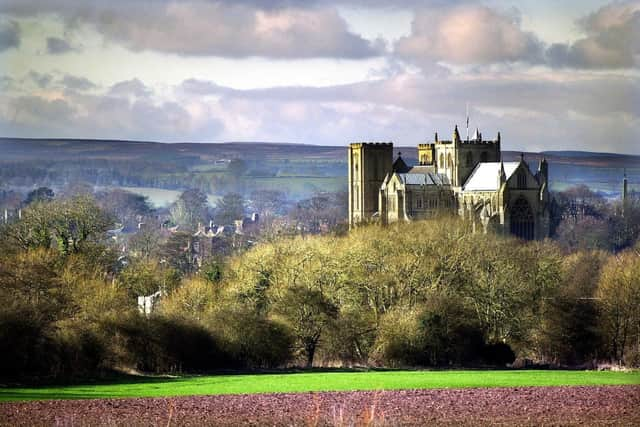Ripon Cathedral to take inspiration from architect who built church 1,350 years ago in bid to become net zero
Plans have been announced by the Church to slash its carbon dioxide emissions and become net zero within just eight years amid the growing threat of climate change and the impact which extreme weather is having on its estate and places of worship.
A consultation has been unveiled by the General Synod, and it is calling on dioceses, cathedrals, national institutions, parishes and schools to help shape the strategy.
Advertisement
Hide AdAdvertisement
Hide AdThe Dean of Ripon, John Dobson, told The Yorkshire Post that a host of measures are being considered for Ripon Cathedral, which will celebrate its 1,350th anniversary next year.


The Dean said: “We have got to be bold and it is a huge challenge but we must see it as an opportunity as well. When St Wilfrid built Ripon Cathedral, he took inspiration from his time in Rome, and what was created was unimaginable at the time in this part of the country.
“We need to take the spirit in which Wilfrid built the cathedral, we cannot be timid in our approach as dealing with climate change is not negotiable.”
The scale of the challenge facing the Church of England, however, is daunting, with the need to balance protecting centuries-old heritage while introducing new technologies to help curb the impact of climate change.
Advertisement
Hide AdAdvertisement
Hide AdIts estate includes 16,000 parish churches and 42 cathedrals, and it is responsible for 45 per cent of all Grade I listed buildings in England. A total of 8,500 parish churches date from the medieval era or earlier and 12,500 places of worship are listed.
The Government has committed to a target of net zero carbon by 2050, with an interim target of a 78 per cent reduction, which was set in April this year.
The Church of England is already introducing a range of green technologies including solar panels, ground source heat pumps and LED lighting, and increased biodiversity is being promoted across its estates.
A strategy for Ripon Cathedral’s mission, called Growing God’s Kingdom, was launched in 2016 and is being reviewed. A revised strategy for the next five years is due to launch in the New Year, with the environment at the forefront of the proposed document. Work already undertaken at the cathedral includes the introduction of interior LED lighting with a second phase due to get underway to install the technology on spotlights that illuminate the exterior.
Advertisement
Hide AdAdvertisement
Hide AdDiscussions are under way to introduce solar panels on Ripon Cathedral with the hope that planning approval will have been secured by the end of next year.
Double-glazing is being considered for parts of its estate, which includes Thorpe Prebend House and Minster House that are both Grade II* listed. While budgets are still being finalised, the Dean of Ripon said he believed the cost will run into six figures to achieve the net zero target by 2030.
The director of Churches and Cathedrals for the Archbishops’ Council, Becky Clark, said that despite the immense challenge set out in the green strategy, she believed that it was achievable.
She said: “I would really hope that the Church of England can be seen to be a trailblazer across the whole heritage sector by achieving the net zero target by 2030. By setting an ambitious goal, we can prove that it can be done.”
Advertisement
Hide AdAdvertisement
Hide AdThe Bishop of Selby, Dr John Thomson, also called for a unified approach to tackle climate change after overseeing the Church of England’s new environmental strategy.
The draft net zero carbon routemap has been written by a sub-committee of the Church of England’s Environmental Working Group, chaired by Dr Thomson.
He said that the world was in “crisis” with the advent of climate change, and there was a need to address the global emergency, especially for the world’s poorest communities who are being affected the most by extreme weather.